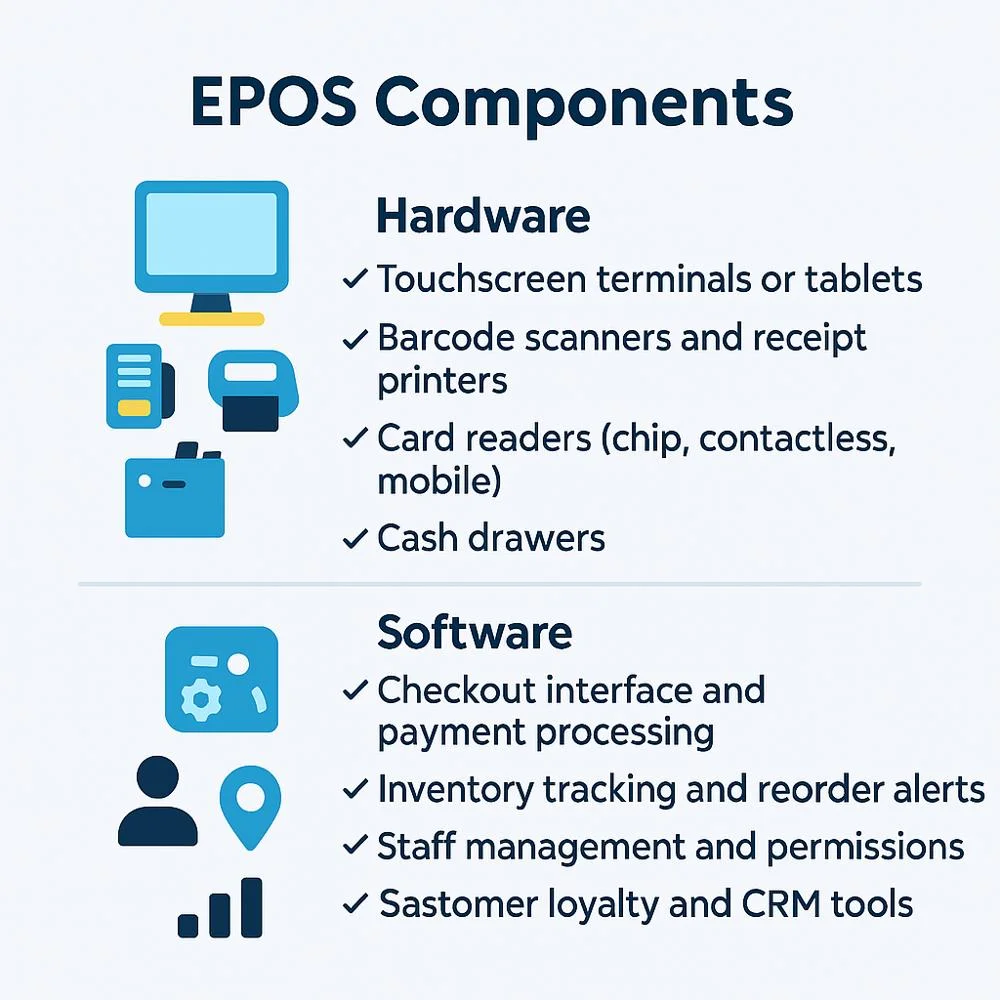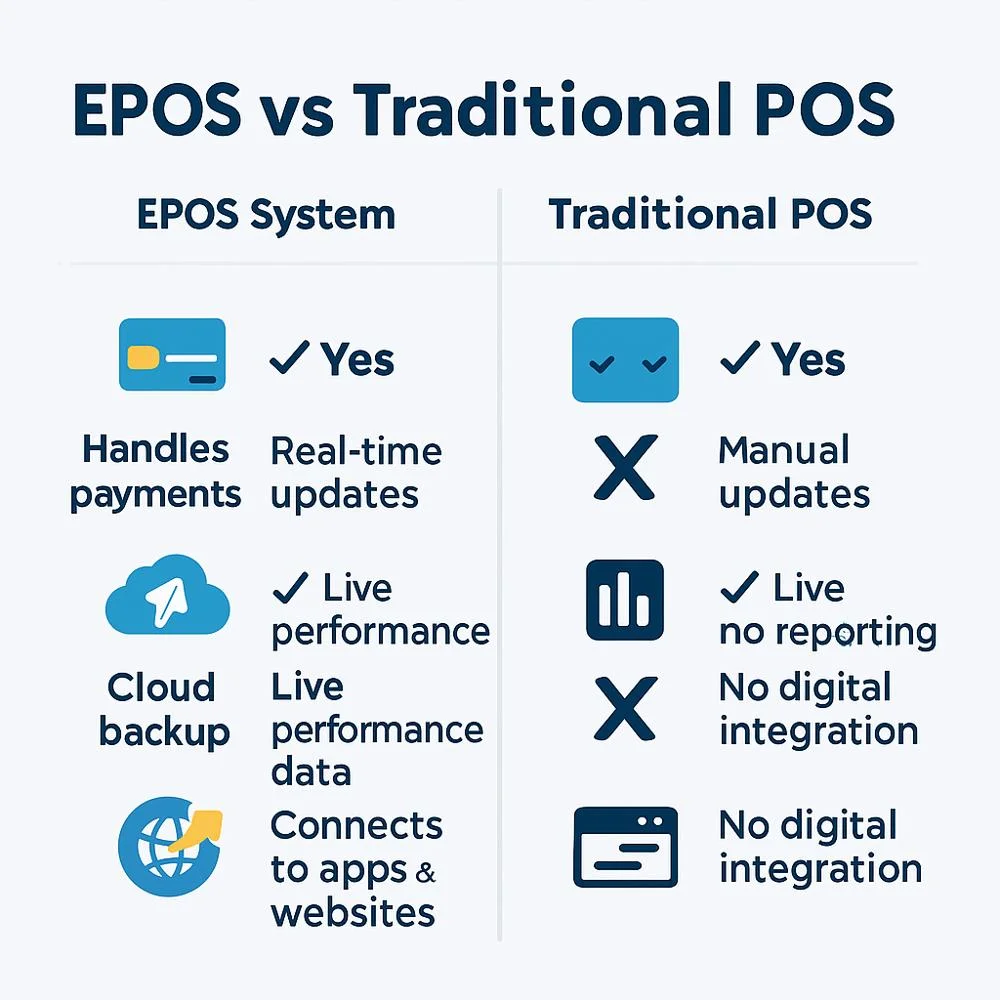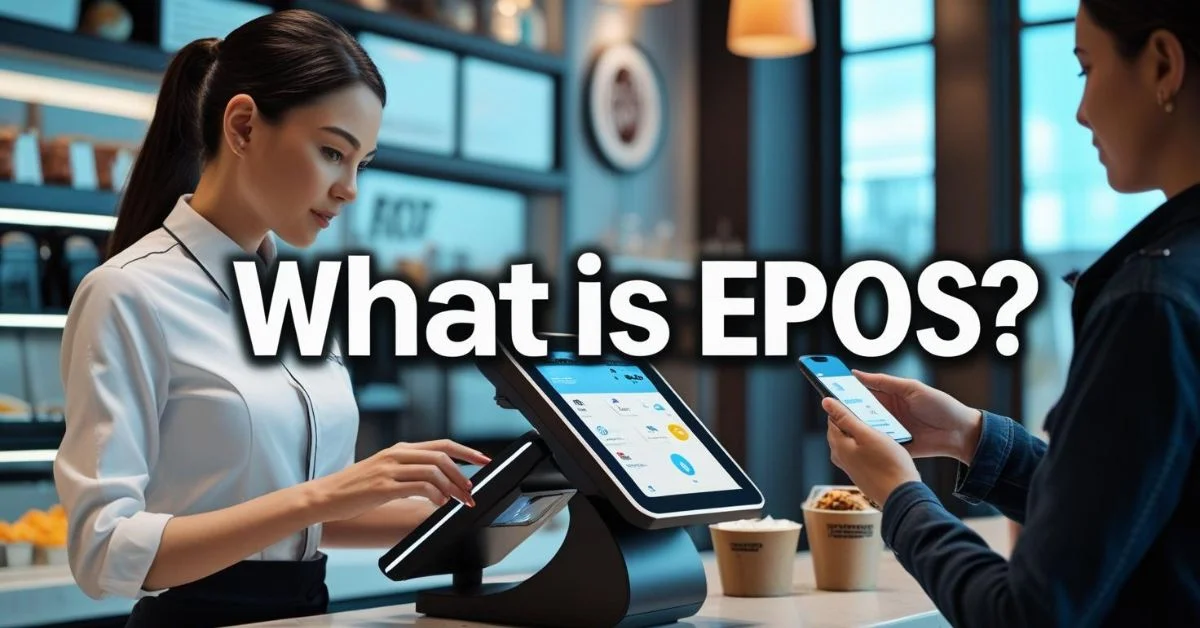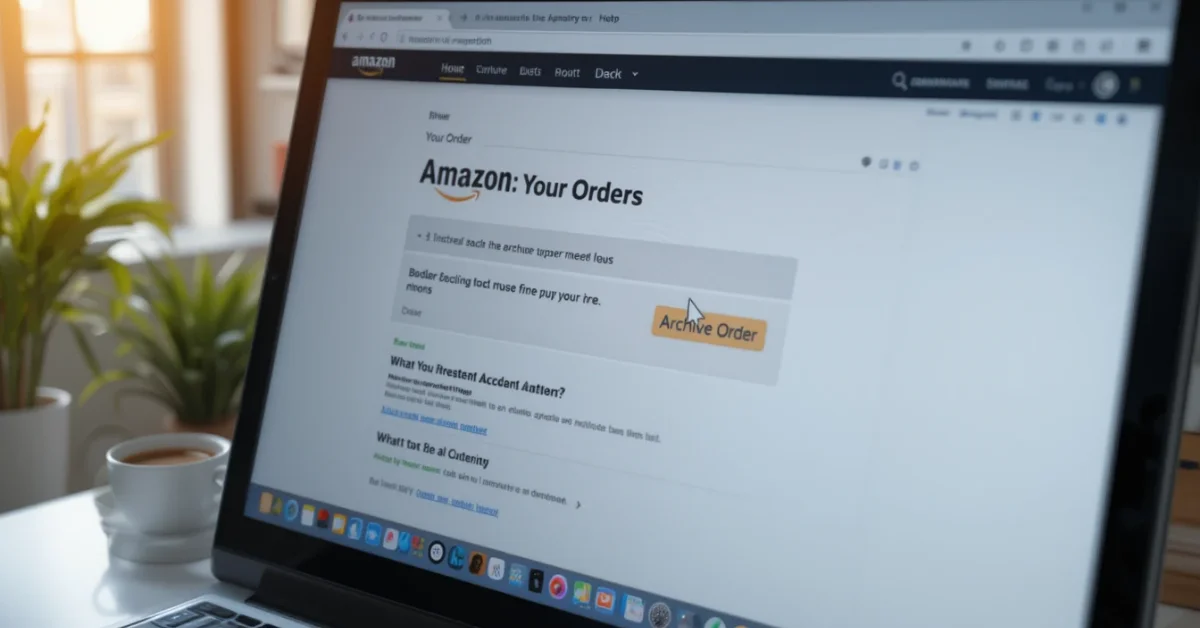An EPOS (Electronic Point of Sale) system is a modern, all-in-one tool that businesses use to handle sales, take payments, track stock and create reports all from one system. Instead of relying on old cash registers and manual stock sheets, EPOS uses smart software and hardware to automate everyday tasks. In 2025, EPOS is no longer a luxury, it’s a necessity for any shop, salon or small store that wants to run smoothly and keep customers happy.
What Is EPOS?
EPOS stands for “Electronic Point of Sale.” It combines hardware (touchscreen terminals, barcode scanners, card readers, receipt printers, cash drawers) and a software platform (billing, inventory tracking, sales reports, customer info). It’s like a smart cash register with brainpower you scan products, calculate prices and taxes, manage stock and get insights on what’s selling well, all in real time.
How EPOS System Works, Simple Steps?
Let’s say you run a small coffee shop. A customer orders a cappuccino. You either scan the item using a barcode reader or select it directly from your screen with a tap. The EPOS system automatically adds the price, applies any discounts, tracks how many cups are left and lets the customer pay using cash or card. A receipt is printed or emailed, and the sale is recorded instantly.
- Scan or choose item: use a barcode scanner or select from touchscreen.
- System calculates total: price, tax, discounts all added automatically.
- Customer pays: via card, mobile tap, cash, or online payment link.
- Stock updates: inventory reduces automatically.
- Receipt issued: printed or emailed instantly.
- Business data stored: transaction saved for reports and analysis
EPOS System Components

1. Hardware
- Touchscreen terminals or tablets
- Barcode scanners and receipt printers
- Card readers (chip, contactless, mobile)
- Cash drawers
- Mobile devices for pop-up sales
2. Software
- Checkout interface and payment processing
- Inventory tracking and reorder alerts
- Staff management and permissions
- Customer loyalty and CRM tools
- Sales and stock reporting dashboards
Why Businesses Need EPOS in 2025?
As businesses grow more digital, EPOS system brings numerous advantages:
- Speed & accuracy: Scanning items and auto-calculating makes checkouts fast and error-free
- Smart stock control: Real-time stock updates prevent both shortages and excess
- Better business insights: Know your best-sellers, busiest hours and top staff
- Flexible payments: Accept digital wallets, contactless pay and mobile scans
- Remote access: Owners can view live data from anywhere
- Enhanced customer service: Loyalty tools and fast checkouts boost satisfaction and repeat visits
- Efficient staff management: Track hours, restrict access and assign roles instantly
Who Should Use EPOS?
EPOS system is ideal for any business making frequent sales including:
- Retail stores: clothing, books, electronics, groceries
- Food service: cafés, restaurants, bakeries, food trucks
- Personal care: salons, spas, barbershops
- Hospitality: hotels, B&Bs, guest houses
- Pop-up vendors: market stalls, mobile services
Cloud-based EPOS systems are perfect for small businesses; they let you start with basics and expand later.
What to Look for in EPOS System? (2025)
- Cloud-based: Centralizes data and enables remote access
- Mobile & card payments: NFC, tap, QR code, wallets
- Integrations: Online store, accounting, delivery apps
- AI analytics: Predictive stock alerts, dynamic pricing, fraud detection
- Security: PCI compliance, tokenization, encryption
- Scalable & local support: Cloud systems should grow with your business
- Ease of use: Interface that staff learn in hours, not weeks
New Trends in 2025
- AI-driven pricing & insights: Dynamically adjust prices, forecast demand and detect fraud.
- Mobile-first & contactless: Handheld terminals, QR code pay, smartwatch tap-ins.
- Cloud everywhere: Data stored online, updates happen automatically, remote access assured.
- Omnichannel sync: Unified stock and sales across web, app and store.
- Voice & biometric payments: Pay with voice commands, fingerprint, face ID soon.
- Self-service EPOS stations and virtual payment apps help customers check out faster, reducing long lines.
EPOS System vs Traditional POS
Here’s how EPOS system compares with traditional POS:

- Handles payments: Both systems can process sales.
- Tracks inventory: EPOS system can automatically update stock in real-time; traditional POS cannot.
- Cloud backup: EPOS system stores data securely online; traditional POS usually doesn’t.
- Real-time reporting: EPOS system offers live sales and performance data; traditional POS lacks this.
- Online integration: EPOS system connects to websites and apps for unified sales; traditional POS doesn’t.
Challenges to Keep in Mind
- Up-front costs: Hardware and monthly plans can add up
- Internet reliance: Need good backup for outages
- Data privacy care: Must ensure strong security and vendor compliance
- Training staff: Need clear support and easy onboarding
How to Choose the Right EPOS?
- List your needs: checkout only, or do you also need CRM, loyalty, analytics?
- Consider budget: subscriptions vs one-time hardware cost
- Check ease of use: demo interfaces, ask staff feedback
- Payment methods supported: card, mobile wallets, contactless
- Security & uptime: PCI-DSS, encryption, 24/7 support
- Integration options: website, accounting software, delivery apps
- Scalability: can it support your growth and next location?
- Local support: having a provider who understands local tax and laws helps
How EPOS Helps Grow Your Business?
In today’s fast-moving business world, just surviving is not enough you want to grow. A modern EPOS system doesn’t just help you sell; it helps you sell smarter. It gives you data, tools and features that can take your small shop or café to the next level.
Here’s how EPOS helps your business grow:
- Tracks What’s Working: EPOS systems track your top-selling items, peak business hours and which team members perform best in sales. This helps you make better decisions, like what to stock more or when to offer discounts.
- Builds Stronger Customer Relationships: Many EPOS systems come with loyalty programs and customer profiles. You can reward repeat buyers, send them offers and remember what they like. This creates trust and keeps them coming back.
- Manages Multiple Locations Easily: If you open a second branch, cloud EPOS lets you manage everything from one place stock, sales, staff and prices. No need for separate systems or messy spreadsheets.
- Boosts Online and Offline Sales Together: EPOS systems now sync with websites, apps and marketplaces. If you sell both online and in-store, EPOS keeps inventory and orders updated in real time.
- Saves Time for Big-Picture Work: When EPOS takes care of routine tasks, like stock counts, sales tracking and receipts, you have more time to focus on growing your business, marketing or launching new products.
- In short, an EPOS system doesn’t just save effort it creates opportunity. The insights and automation it provide help you plan smarter, serve better and grow faster in 2025.
Conclusion
By 2025, EPOS has become more than just a sales tool it acts like a smart assistant that helps run your business better. it speeds up sales, automates inventory, provides meaningful insights, supports modern payments and helps deliver great customer service.
Instead of just scanning and printing receipts, you get a powerful tool that informs decisions, reduces errors and frees you to focus on growing your business. Choose a system that’s easy to use, secure, flexible, and aligned with your plan’s growth.



